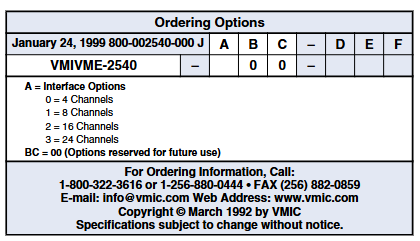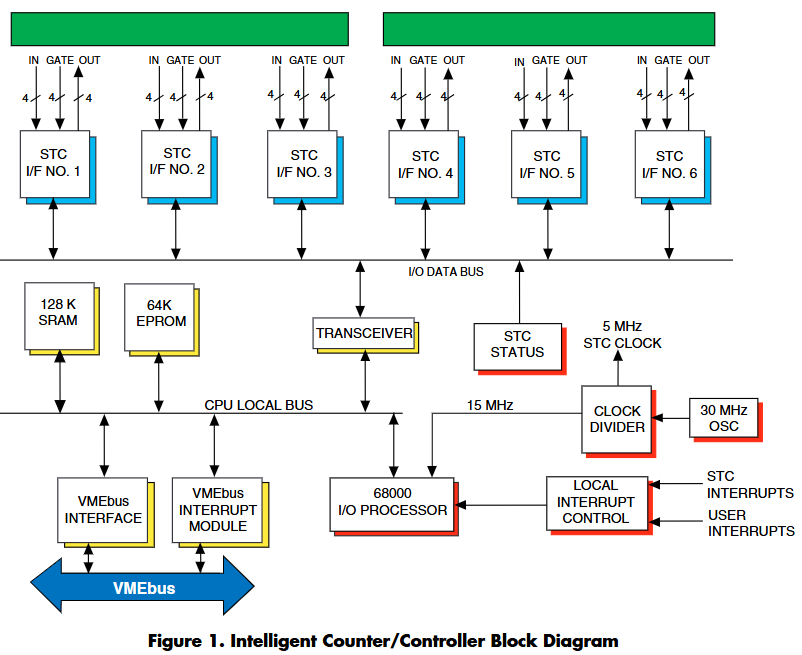What application areas is GE VMIVME-2540 24 Channel Intelligent Counter/Controller suitable for?
What application areas is GE VMIVME-2540 24 Channel Intelligent Counter/Controller suitable for?
Product Overview
VMIVME-2540 is a 24 channel intelligent counter/controller that serves as a slave I/O module for VMEbus systems, providing high-precision digital measurement and function generation capabilities. It features a simple and consistent memory mapped user interface. It consists of three parts: a VMEbus slave DTB interface, a CPU with firmware and supporting logic, and a circuit for implementing measurement and control functions. It is equipped with a 15 MHz 68HC000 CPU, supports A32/A24/D32/D16/D8 (EO) VMEbus slave interfaces and a 64 Kbyte VMEbus memory window. The data exchange interface complies with ANSI/IEEE standard 754-1985 (32-bit floating-point operation).
Core functions and parameters
Measurement function
Event Count: Up to 4 billion events, with an input frequency range of up to 2.5 MHz. The counting range can reach 232 in long mode and 216 in word mode.
Frequency measurement: ranging from -1.16 × 10-3 Hz to 2.5 MHz; The maximum accuracy of a 16 bit counter is 0.015% between 0.007 and 76 Hz, and the error is 100 × (frequency/5 MHz) between 76 Hz and 2.5 MHz; The 16 bit enhanced resolution counter (requires two 16 bit counters) has a range of 0.001 Hz to 1.25 MHz.
Cycle/pulse width measurement: Supports 16 bit and 32-bit, discrete or continuous modes, with low data transmission latency. The range of a 16 bit counter is 131.07 s to 400 ns, and the range of a 16 bit enhanced resolution counter (requiring two 16 bit counters) is 858.9 s to 800 ns. In 32-bit integer operations, two 16 bit counters are required for pulse width measurement, and three 16 bit counters are required for cycle measurement.
Orthogonal position measurement: sine/cosine input range from DC to 1 MHz, 32-bit counter, supports limit/modulus check, accuracy is ± 1/4 wave (5 MHz sampling rate), each encoder requires two channels.

Generate function
Square wave/pulse sequence generation: frequency range from 0.0076 Hz to 2.5 MHz.
Timer/Periodic VMEbus Interrupter: Frequency range from 0.0076 to 1000 Hz.
Pulse sequence mode: can generate a sequence of N pulses, with programmable duty cycle.
Orthogonal position control output: ± 1/4 wave control resolution, up to 1.25 MHz step speed and ± 32767 steps/command.
Other functions
Event triggered timer delay: Generate VMEbus interrupt at most 131.1 seconds after input at the event edge, which can be triggered again.
24 control/measurement interfaces: including 24 clocks, 24 gates, and 24 outputs.
Supports RS-422 differential interface and single ended TTL input.
Options for configuring 4, 8, 16, and 24 interfaces.
System and Physical Specifications
System time base: 5 MHz, accuracy/stability of ± 0.005%.
Power requirements:+5 V ± 5/-2.5%, typical 4.25 A, maximum 5 A.
Temperature range: Operating temperature from 0 to 65 ° C, non operating temperature from -40 to 85 ° C, humidity from 5 to 95% RH without condensation.
VMEbus compatibility: Complies with ANSI/IEEE 1014-1987, IEC 821 and 297, supports A32/D32 DTB slaves, base address can be selected on a 64 Kbyte boundary, supports monitoring/non privileged address modification codes, dual interrupt module can assert any one of IRQ1 to IRQ7, board size 160 × 233.4 mm.

Input/output buffer specifications
Input buffer
Common mode voltage limit: ± 25 V.
Differential mode voltage limit: ± 5 V (due to 1/4 W, 120 Ω terminal resistance).
Differential mode V IH/V IL: Compliant with RS-422 standard, V IH refers to the main (positive) input voltage being 100 mV higher than the differential (negative) input voltage within the ± 25 V common mode voltage range; V IL refers to the main (positive) input voltage being 100 mV lower than the differential (negative) input voltage within the ± 25 V common mode voltage range.
Single pole (single ended) mode V IH/V IL: V IH=V TTL+100mV, V IL=V TTL − 100mV.
Input lag: 50 mV.
Suggested input rise time: minimum 5 ns, typical propagation delay 25 ns, maximum 1 ms.
Output buffer
AM26LS31 is used.
Short circuit current: Typical I SC=-60mA.
Differential output voltage: minimum ∣ V t ∣=2V.
Interface and Connection
Discrete wire connectors and terminal blocks: It is recommended to use connector components from Harting Elektronik, Inc., such as 96 pin discrete wire connectors (model 0903-096-3214).
RS-422 differential signal: Twisted pair insulated wire (24 AWG solid or multi stranded copper conductor) should be used,
R<30Ω/1000
ft), The maximum cable length is 4000 feet, and it is necessary to ensure that each signal group is properly grounded.
TTL signal: 96 conductor flat ribbon cable (30 AWG insulated copper multi strand conductor) can be used, corresponding to ERNI 913.031 or similar 96 pin DIN female connector. It is recommended that the total cable length not exceed 50 feet.
If the front panel I/O signal needs to be led out to the terminal block, it is recommended to use VMIAC-BT04 dual 96 pin transition panel and connect it through a 96 conductor ribbon cable (recommended to be 3 feet long).
Application field
Including rotary axis instruments (angular position, velocity, acceleration), automotive industry testing (brakes, transmissions, tachometers), robotics, telescopes/observatories, medical/laboratory instruments, linear position measurement (distance, velocity, acceleration), elevators, bridge cranes, X-Y workbenches, machine tools, automatic storage and retrieval, etc.

- EMERSON
- Honeywell
- CTI
- Rolls-Royce
- General Electric
- Woodward
- Yaskawa
- xYCOM
- Motorola
- Siemens
- Rockwell
- ABB
- B&R
- HIMA
- Construction site
- electricity
- Automobile market
- PLC
- DCS
- Motor drivers
- VSD
- Implications
- cement
- CO2
- CEM
- methane
- Artificial intelligence
- Titanic
- Solar energy
- Hydrogen fuel cell
- Hydrogen and fuel cells
- Hydrogen and oxygen fuel cells
- tyre
- Chemical fiber
- dynamo
- corpuscle
- Pulp and paper
- printing
- fossil
- FANUC
- Food and beverage
- Life science
- Sewage treatment
- Personal care
- electricity
- boats
- infrastructure
- Automobile industry
- metallurgy
- Nuclear power generation
- Geothermal power generation
- Water and wastewater
- Infrastructure construction
- Mine hazard
- steel
- papermaking
- Natural gas industry
- Infrastructure construction
- Power and energy
- Rubber and plastic
- Renewable energy
- pharmacy
- mining
- Plastic industry
- Schneider
- Kongsberg
- NI
- Wind energy
- International petroleum
- International new energy network
- gas
- WATLOW
- ProSoft
- SEW
- wind
- ADVANCED
- Reliance
- YOKOGAWA
- TRICONEX
- FOXBORO
- METSO
- MAN
- Advantest
- ADVANCED
- ALSTOM
- Control Wave
- AB
- AMAT
- STUDER
- KONGSBERG
- MOTOROLA
- DANAHER MOTION
- Bently
- Galil
- EATON
- MOLEX
- Triconex
- DEIF
- B&W
- ZYGO
- Aerotech
- DANFOSS


email:1583694102@qq.com
wang@kongjiangauto.com




































![Applied Materials 0020-28205 - 124-0101 AMAT APPLIED COVER RING, 6 101% HI-PWR COH [REFURBISHED]](https://hkw170181-pic8.websiteonline.cn/upload/AppliedmaterialsAMAT0090-04468CONTROLLERRTCCPCICENTURAAPCP3450-S0006073_dps3.png)







![Applied Materials 0020-20691 - 120-0501 AMAT APPLIED PEDESTAL CD/PT WAFER200 MM [REFURBISHED]](https://hkw170181-pic8.websiteonline.cn/upload/AMATAPPLIEDMATERIALS0190-51379RFGPLASMAGENERATORSSM3000TRUMPFHUTTINGER3_20g6.png)









































